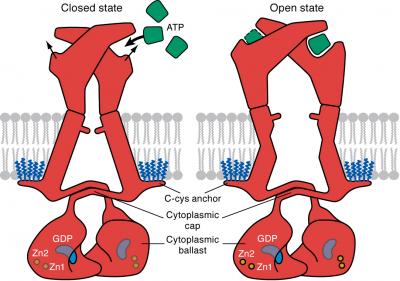Protein associated with many diseases fully visualized for first time

An illustration shows how the P2X7 protein receptor opens and closes, allowing charged particles to enter a cell and trigger cellular changes. OHSU resarchers used cryoelectron microscopy to obtain the protein's 3D structure for the first time. P2X7 is associated with many diseases, including inflammation, coronary artery disease, cancer and multiple sclerosis. Credit: Oregon Health & Science University
For the first time, researchers have observed at the molecular level how a protein associated with numerous health problems works.
The discovery – which could one day inspire new drugs to treat inflammation, coronary artery disease, cancer, multiple sclerosis and more – was published today in the journal Cell.
Oregon Health & Science University research assistant Alanna McCarthy, B.S., and OHSU researcher Steven Mansoor, M.D., Ph.D., used cryoelectron microscopy to obtain the 3D structure of a protein receptor and observe its inner workings. The protein receptor they studied is a cellular membrane protein that allows electrically charged sodium and calcium particles to enter and trigger changes in a cell.
They specifically studied the P2X7 receptor, a subtype of the ligand-gated ion channel P2X family that has been associated with inflammation, plaque buildup in arteries, cancer metastasis, neurological conditions and more.
P2X7 is unusual because once activated, its channel remains open indefinitely, continually allowing charged particles to enter a cell and trigger the signaling pathways of inflammation, ultimately leading to cell death. Such signaling behavior could contribute to the long list of ailments that are associated with the receptor.
Unlike previous efforts to image the P2X7 receptor, the team's cryo-EM imaging approach allowed them to capture the protein receptor in its entirety.
This enabled them to visualize the parts of the receptor that sit inside the cell. As a result, they were able to directly observe how these parts are modified with fatty acid molecules called palmitoyl groups. When Mansoor and his colleagues removed these groups, they found the receptor no longer stayed open indefinitely, shutting down its ability to trigger signaling. They also unexpectedly discovered a guanosine nucleotide was bound to P2X7 inside the cell.
“Researchers have known ligand-gated ion channels are modified by palmitoyl groups, but we had never directly observed it until now,” said Mansoor, an assistant professor of medicine (cardiovascular) in the OHSU School of Medicine and Knight Cardiovascular Institute. “Our finding could be used as a model of how palmitoylation modifies other ion channels.”
Mansoor and his team will further explore the roles that palmitoyl groups and the guanosine nucleotide play in P2X7 intra-cellular signaling, their potential impact on human health, and how they could be targeted to treat health conditions associated with the receptor.
###
This research was supported by the National Heart, Lung and Blood Institute (grant K99HL138129). The team used microscopes at the Pacific Northwest Center for Cryo-EM, which OHSU and Pacific Northwest National Laboratory established in 2018 with support of the National Institutes of Health, and conducted research in the OHSU Vollum Institute lab of Eric Gouaux, Ph.D., who is supported by the Howard Hughes Medical Institute.
REFERENCE: Alanna E. McCarthy, Craig Yoshioka, Steven E. Mansoor, Full-length P2X7 structures reveal how palmitoylation prevents channel desensitization, Cell, 11 a.m. ET Oct. 3, 2019, DOI: 10.1016/j.cell.2019.09.017, https:/
Related OHSU News Stories:
* 9/14/16 OHSU News Hub story, “Study in Nature Reveals News Molecular Insight,” https:/
* 5/15/18 OHSU News Hub story, “OHSU one of three centers selected to study cells at atomic level,” https:/
Other Links:
* Steven Mansoor, M.D., Ph.D., https:/
* OHSU Foundation Onward Magazine, July 1, 2017, “Up-and-comers: Steven Mansoor,” https:/
Media Contact
More Information:
http://dx.doi.org/10.1016/j.cell.2019.09.017All latest news from the category: Life Sciences and Chemistry
Articles and reports from the Life Sciences and chemistry area deal with applied and basic research into modern biology, chemistry and human medicine.
Valuable information can be found on a range of life sciences fields including bacteriology, biochemistry, bionics, bioinformatics, biophysics, biotechnology, genetics, geobotany, human biology, marine biology, microbiology, molecular biology, cellular biology, zoology, bioinorganic chemistry, microchemistry and environmental chemistry.
Newest articles

A ‘language’ for ML models to predict nanopore properties
A large number of 2D materials like graphene can have nanopores – small holes formed by missing atoms through which foreign substances can pass. The properties of these nanopores dictate many…

Clinically validated, wearable ultrasound patch
… for continuous blood pressure monitoring. A team of researchers at the University of California San Diego has developed a new and improved wearable ultrasound patch for continuous and noninvasive…

A new puzzle piece for string theory research
Dr. Ksenia Fedosova from the Cluster of Excellence Mathematics Münster, along with an international research team, has proven a conjecture in string theory that physicists had proposed regarding certain equations….



